Creating keyword clusters is one of the best ways to improve your organic search traffic.
By utilising the keyword clustering method of content creation and optimisation, you can ensure that the content you are creating is targeting the highest number of search queries it can, whilst also reducing risks of content cannibalisation.
In this blog post, we are going to run through some of the best keyword clustering tools you can use. Within this post we have a range of tools that will suit all needs and budgets.
What is keyword clustering?
Keyword clustering is the process of creating one piece of content per “cluster” of keywords. For example, if I was creating a blog post on the topic of keyword cannibalisation, I want to ensure I am targeting as many related queries as possible.
These queries could include:
- Keyword cannibalization risks
- Keyword cannibalization tools
- How to prevent keyword cannibalization
- How to fix keyword cannibalization
You may find, depending on the main keyword you are targeting, you can create one piece of content and target all of these related keywords. This is referred to as a keyword cluster.
Want to find out more about keyword clustering? Andy and Suganthan at Keyword Insights have written a great blog post on the subject.
Why should I use a keyword clustering tool?
Using a keyword clustering tool, such as the tools we’ll list later on, is a must if you want to start creating content in clusters.
Using these tools will take the guesswork out of creating clusters, all whilst saving you time and money.
Keyword clustering tools will allow you to input a list of “seed” keywords and find all the possible content clusters for these tools in minutes. Whilst also removing the possibility of spending time and money on creating content only to find two (or more) pieces of content target the same queries.
What are the benefits of using keyword clustering tools?
There are several benefits to using keyword clustering tools, but the main benefits consist of:
Automation: Using keyword clustering tools will allow you to almost completely automate the process of creating keyword clusters. Most of these tools will allow you to input a list of seed keywords, taken from your own research or a keyword research tool like Keywords Everywhere or Keyword Surfer, and return spreadsheets filled with the keyword clusters you need to create content for.
Time savings: Creating content clusters “by hand” takes time. Using keyword clustering tools like these will save you countless hours in the creation phase and will allow you to spend more time creating amazing content for these keyword clusters to give it the best chance of ranking.
Mistake elimination: There is a lot of guesswork involved in manual content cluster design. Most of these tools make use of machine learning to create the keyword clusters for you, eliminating any mistakes you may make.
What are the best keyword clustering tools?
Here are some of the best keyword clustering tools our team have used over the last couple of years.
Keyword Insights
Keyword Insights is an AI driven content marketing platform with a world-leading keyword clustering feature.
Within the tool you can discover keywords from a simple seed keyword, cluster them and export pivot tables so you know exactly what content you need to create for which cluster, classify the search intent of each keyword and cluster, and draft content briefs all within the same tool.
Focussing specifically on the keyword clustering feature, Keyword Insights allows you to take the guesswork out of your content production. It uses live search results pages to group keywords based on what’s ranking, so you know (in seconds) when a page should be broken out into sub-topics to stand the best chance of ranking.
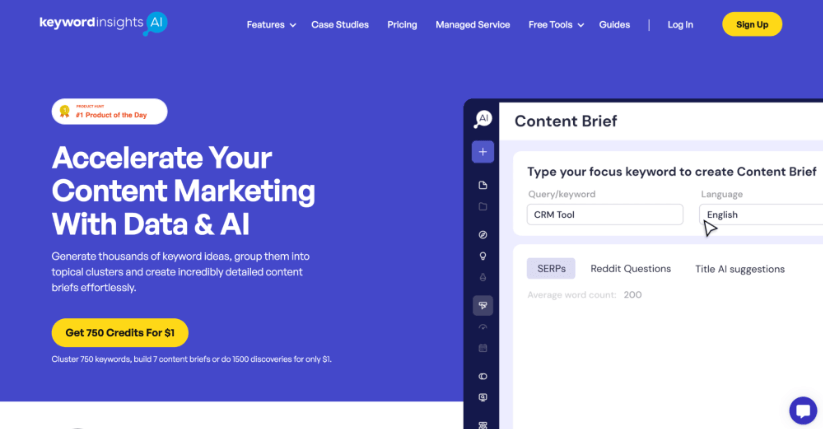
Keyword Insights is, perhaps, the most comprehensive keyword clustering tool on the market currently. It can take large, unfiltered and cluttered keyword lists and convert them into data-backed cluster documents and allow you to manage the entire process, from discovery through to content briefs for you or your writers to use.
Whilst the tool has a large number of strengths, it can sometimes be slow to run reports depending on the number of keywords you are analysing. It is not uncommon for a report to take a few hours to run, so keep this in mind when you are wanting to work quickly.
Keyword Insights operates on a credit-based system. It has monthly subscription pricing, annual subscription pricing and a pay-as-you-go pricing model.
The “Basic” plan will cost you $49/month on a monthly billing cycle or $550 for the year. This gives you 6,000 credits per month to use. The most expensive “Agency” plan will cost you $599 per month or $6,589 for the year. This gives you access to 100,000 credits per month.
On the pay-as-you-go pricing model, 1,000 credits will cost you $15.98, 10,000 credits will cost you $159.80, 100,000 credits will cost you $1,598. Monthly subscribers can also purchase additional credits at a discounted rate.

ClusterAi
ClusterAi is not a tool, but a type of artificial intelligence that uses multiple machines to learn and process information. ClusterAi will crawl and extract the top 10 search results for each keyword you input and use that information to make recommendations on clusters for you to use in your content.
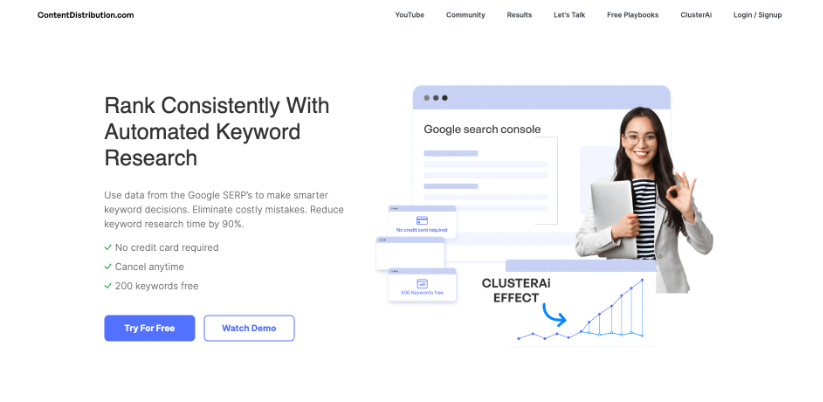
ClusterAi is incredibly process-driven. It starts with importing a keyword list. The larger the list of keywords inputted initially, the better the results ClusterAi will deliver. The AI will then use data from search engines themselves to make keyword decisions by crawling and retrieving the top 10 websites ranking for each keyword. It will then compare every keyword against every other keyword and compare the number of pages that rank for both sets of keywords. If it finds 3 (or more) pages that rank for a set of keywords, it will place these into a cluster.
There are a few pros to using ClusterAi in your keyword research and keyword clustering processes. It’s incredibly fast and works as intended for keyword research. Clustered keywords can be downloaded in Microsoft Excel format and, even with being a type of artificial intelligence, it is very easy to use.
ClusterAi does not have any ability to find keywords for you, so you will need to input your own keyword list. Often this means using a tool such as Ahrefs or Semrush for your keyword research, which can be expensive.
Unfortunately, there is no pricing data available on the Content Distribution website, which makes finding pricing information incredibly difficult. You can try 200 keywords for free, to start off with. Looking at another website, the pricing structure is based on a credit system.
- Hobbyist
- $39
- 1,000 credits
- Consultant
- $89
- 5,000 credits
- Team
- $179
- 15,000 credits
- Team+
- $249
- 25,000 credits
- Agency
- $389
- 50,000 credits
- Enterprise+
- $699
- 100,000 credits
Keyword Cupid
Keyword Cupid uses state-of-the-art neural network models in order to reverse engineer Google’s “knowledge graph” in real time. It scrapes live data from the SERPs to train machine learning models. This will allow the tool to provide you with an optimised and holistic content strategy.
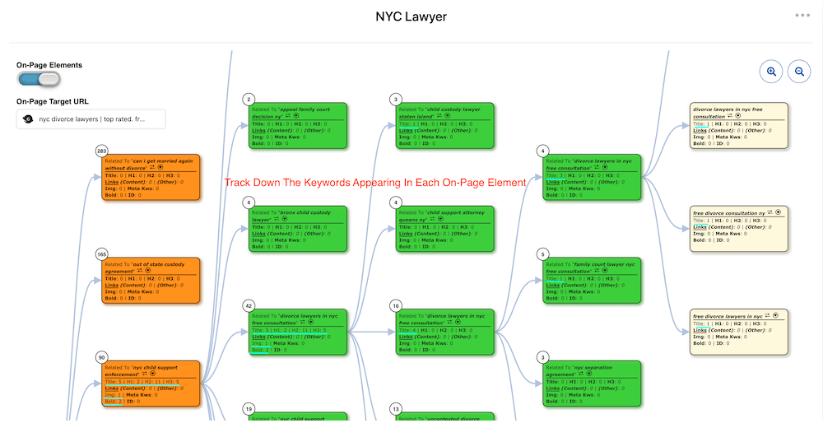
It works by collecting all the relevant keyword data for your target market. As it trains AI models in real time, the more data you feed it, the better the patterns it discovers. You can upload a seed list of keywords from a tool such as Ahrefs or Semrush in a CSV file. Once it has done this, it will scrape the SERPs for all of your keywords in order to train its models. Once the report is done, you will receive an email. From there, you can access the tool’s interactive mind map, allowing you to visualise your keywords and keyword clusters.
Keyword Cupid’s main advantage over other keyword clustering tools is the fact that it uses a five-layer neural net that processes text by “vectorising” words. Other traditional keyword clustering tools find 3 or more URLs that rank for a set of keywords and place these into a cluster. There is nothing wrong with this approach, but it still leaves small room for error. This eliminates some of that risk.
Whilst the tool itself is great, there are some elements of the UI that could be improved. Some of the tool looks basic when compared to competitors like Keyword Insights and SEO Scout.
Keyword Cupid operates on a monthly subscription model. You can purchase a “Starter” subscription for $9.99 per month which will give you access to 500 credits. The “Freelancer” subscription is $49.99 per month and grants you 5,000 keyword credits. The “Agency” package lists at $149.99 per month and grants you access to 20,000 keyword credits. The “Enterprise” subscription is $499.99 per month and allows access to 80,000 credits.
SEO Scout’s Keyword Grouping Tool
Rather than “just” a keyword clustering tool, SEO Scout is a suite of SEO tools designed to help you improve organic performance. Their Keyword Grouping Tool automatically pulls together related keywords, questions and suggestions they have gathered from in-depth research.
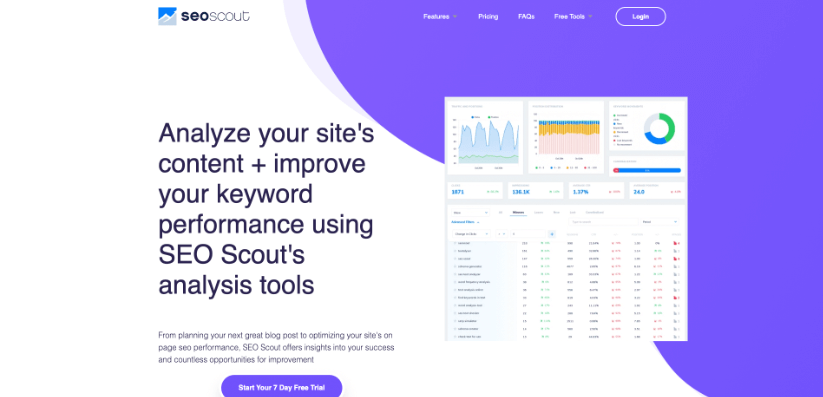
You will be able to see, at a glance, the range of long-tail keywords each keyword group represents and the total potential search volume of all your keyword groups (or clusters). Each content group can be sent into SEO Scout’s content planner where you can build articles.
Because SEO Scout’s Keyword Grouping Tool is part of a wider stack, the tools interlink very well. It is an easy process to take keyword groups and directly import them into SEO Scout’s content planner, for example. This is a great way to streamline your process and make your SEO workflow more efficient.
As SEO Scout’s Keyword Grouping Tool is not a standalone tool and is part of a wider stack, you may find that the tool is not advanced enough for your needs. If you’re working as a freelancer on small sites or you’re in-house, working on one website, then you may find that the tool is perfect for you. But if you rely on creating lots of content for different brands and websites, you may need a standalone keyword clustering tool as part of your stack.
SEO Scout operates on a monthly or annual subscription model.
The “Starter” membership costs $49 per month and will allow you to optimise 10 articles per month, explore hundreds of keyword ideas, spy on competitor rankings and track unlimited keywords.
The “Business” membership runs at $99 per month and allows you to optimise 30 articles per month, get 4x the keyword data, track up to 10 sites’ performance and crawl 10,000 pages per website. On top of all you get in the Starter membership.
The “Agency” subscription costs $199 per month and gives you access to optimise 60+ pieces of content per month, get 8x the keyword data when compared to the Starter plan, track the performance of up to 25 sites, and crawl 500,000 pages per website.
SE Ranking Keyword Grouper
SE Ranking‘s Keyword Grouper is part of their wider SEO tool stack. It will allow you to segment keyword for further distribution across your website, plan the SEO architecture of your website for the future and even get higher scores and save money through keyword grouping on PPC campaigns.
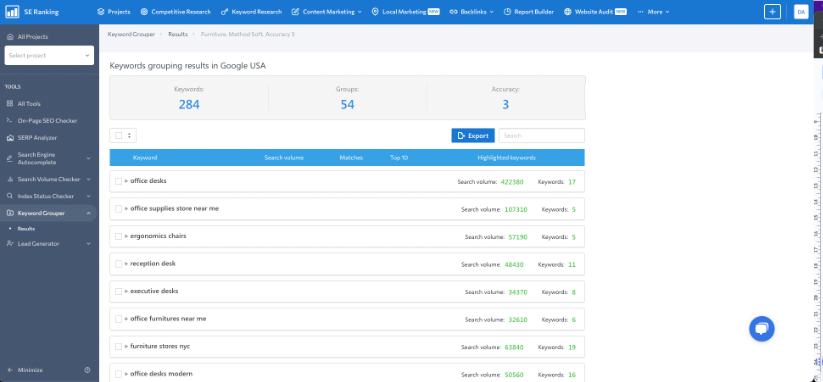
Much like the other keyword clustering tools in this list, SE Ranking’s Keyword Grouper allows you to start with a list of seed keywords that need to be clustered, this can be taken from their tool itself or another tool like Ahrefs, Semrush or Google Search Console. It will then group keywords together based on matching URLs and list out your keyword clusters, the potential search volume for each cluster and the number of keywords within each cluster.
Where SE Ranking’s Keyword Grouper really excels is its personalisation. You can take into consideration the country, location and language whilst grouping keywords, making this a great tool for agencies who have clients in different locations. It also allows you to personally define the minimum number of matching URLs to form a cluster, meaning you can create clusters with much higher accuracy.
Despite the fact that SE Ranking’s Keyword Grouper forms part of a wider toolset, the functionality and communication between the different tools in its stack are limited. You can export the clusters to a Microsoft Excel file or a CSV file, but from my usage I could not find a way to directly use these clusters in other tools within the software. This is where a tool like Keyword Insights or SEO Scout takes the lead as these will communicate between different tools in their stack well.
As with SEO Scout, SE Ranking operates on a monthly or annual subscription.
The “Essential” subscription lists at £45 per month and gives you 10 projects, 1 user seat and 5 competitors per project. The “Pro” subscription is £89 per month and gives you access to unlimited projects, 3 user seats and up to 10 competitors per project. The “Business” plan is £189 per month and gives you access to unlimited projects, 5 user seats and up to 20 competitors per project.
KeyWI
KeyWI is an AI-based content marketing platform with tools that help generating content ideas, generating content briefs, content improvement suggestions and SEO optimisation suggestions, all based on their in-house built algorithm.
KeyWI, rather than “just” a keyword clustering tool is a suite of tools that will help you curate, create and rank content.
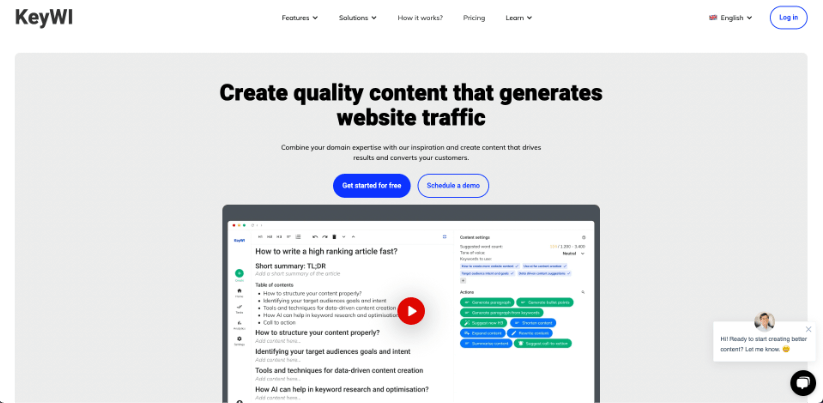
Much like other tools within this list, KeyWI will allow you to add in a list of seed keywords and will group these together based on the URLs found in the SERPs for each keyword and not language-ties. You can then visualise these keyword clusters and move on to creating content that is going to rank for all of these.
Whilst the tool itself is great and the pricing option is favourable, there is nothing that I have found through my use of the tool that separates it from the competition. This means your use of the tool is going to come down to personal preference. There are other AI tools on the market that do similar things to KeyWI.
KeyWI operates a monthly and annual subscription. The lowest-tier “Basic” plan starts at 39 Euros per month and gives you 3 content briefs per month, a single user seat, basic analytics and one language per project.
The “Standard” plan comes in at 89 Euros per month and gives you 10 content briefs per month, up to 3 user seats, advanced analytics, one language per project and email support.
The “Pro” plan lists at 189 Euros per month and gives you 20 content briefs, unlimited user seats, advanced analytics, one language per project, full technical support, a white labelling option and an API connection.
KeyClusters
KeyClusters is a specialist keyword clustering tool that uses real-time Google SERP data to create topical clusters so you know what pages to create and how to interlink them. Their goal is to eliminate the guesswork that comes from manually creating content clusters and the hours of keyword research that requires.
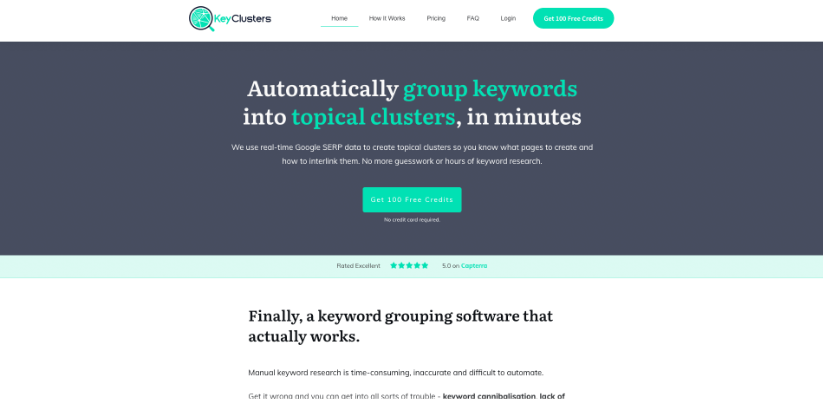
KeyClusters operates on a similar model to Keyword Insights. It allows you to upload a list of keywords in the form of a CSV file, taken from the tool of your choice (like Google Search Console, Semrush or Ahrefs). The difference between KeyClusters and other tools is that they have a direct integration with Semrush and Ahrefs so you can connect these tools well.
KeyClusters will then run every keyword in your list through Google, analyse the top 10 URLs found in each Google SERP for each keyword and cluster keywords that have 3 or more pages in common. Then, within a few minutes, you’ll get an Excel file with all of your keywords, clustered into topical groups.
There are lots of good things to say about KeyClusters, especially when we come to the UI and the speed the tool takes. The UI is very intuitive to use and is very easy to navigate, even if you are using the tool for the very first time. The tool took around 3 minutes to analyse and cluster 1,000 keywords. This is incredibly quick, especially given they scrape Google SERPs in real-time.
KeyClusters does not operate a subscription model and are pay-as-you-go only. You can purchase keywords for the following prices:
- 1,000 keywords
- $9
- 2,500 keywords
- $19
- 5,000 keywords
- $34
- 10,000 keywords
- $59
- 20,000 keywords
- $110
- 30,000 keywords
- $149
As a final note. Did you know you can run a test to find out whether an article will perform better as a standalone article or as part of a wider topic cluster? We show you that exact process in this blog post on how to run an SEO test for a new topic cluster.
I hope this blog post has given you a better understanding of the keyword clustering tools you can use to your advantage to improve your content marketing and organic traffic. We tested a lot of different tools, all with different strengths and weaknesses as well as price points to give you the best knowledge possible.
If you are looking to make the most of your Google Search Console data and use it to improve your organic traffic, give SEOTesting a try. We run a 14-day free trial with no credit card required!


